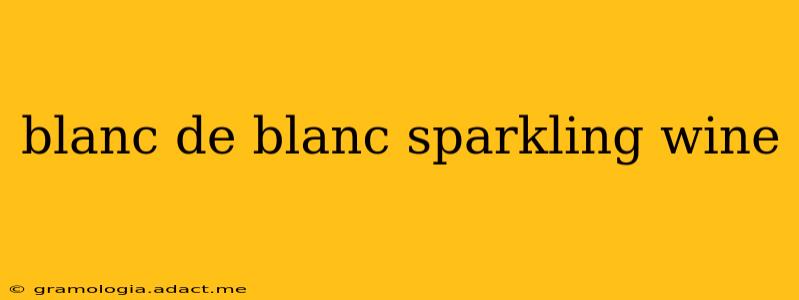Blanc de Blancs, translating literally from French as "white of whites," refers to sparkling wines made exclusively from white grapes. This seemingly simple detail leads to a world of nuanced flavor profiles and production techniques, making it a fascinating subject for wine enthusiasts of all levels. This comprehensive guide delves into the characteristics, production methods, and notable regions of Blanc de Blancs sparkling wines, answering many frequently asked questions.
What Makes Blanc de Blancs Special?
The defining characteristic of Blanc de Blancs is its singular origin: white grapes. This purity of varietal expression allows for a more focused and often more delicate style of sparkling wine compared to blends which may include red grapes or a mixture of white varieties. The most common grape used is Chardonnay, known for its high acidity and aging potential, lending itself perfectly to the production of elegant, age-worthy Blanc de Blancs. Other white grapes like Pinot Blanc or even Albariño might be used, depending on the region and producer.
What are the Different Styles of Blanc de Blancs?
The style of a Blanc de Blancs can vary significantly based on several factors, including the grape variety, terroir (the environmental factors influencing the grape), winemaking techniques, and aging. Generally, you can expect to encounter styles ranging from:
- Crisp and mineral-driven: Often featuring bright acidity, citrus notes, and a flinty minerality. These are typically younger, less complex wines ideal for enjoying fresh.
- Rich and creamy: These wines benefit from longer aging, developing complex aromas of baked apple, brioche, and hazelnut. Their texture is often richer and fuller-bodied.
- Elegant and refined: Many Blanc de Blancs fall somewhere between these two extremes, offering a balance of acidity, complexity, and elegance.
What are the Best Blanc de Blancs Regions?
While Blanc de Blancs can be produced globally, certain regions are particularly renowned for their expertise in crafting these exquisite wines:
- Champagne, France: The undisputed king of Blanc de Blancs, Champagne produces some of the most sought-after and age-worthy examples. The chalky soils of the region contribute significantly to the minerality and finesse of the wines.
- Burgundy, France: While not solely dedicated to sparkling wine, Burgundy also produces outstanding Blanc de Blancs, often using Chardonnay from their prestigious vineyards.
- Crémant de Bourgogne, France: This region produces a wide range of sparkling wines, including many excellent Blanc de Blancs, often at more accessible price points than Champagne.
- Other Regions: Many other regions worldwide are exploring Blanc de Blancs production, with increasing success. Look for examples from Italy, Spain, and California.
What is the Difference Between Blanc de Blancs and Other Sparkling Wines?
The key difference lies in the grape varieties used. Blanc de Blancs is exclusively made from white grapes, while other sparkling wines might include red grapes (as in Blanc de Noirs) or a blend of white and red grapes. This results in distinct flavor profiles; Blanc de Blancs are generally known for their delicate and nuanced flavors, while blends can offer greater complexity and intensity.
Is Blanc de Blancs Better Than Other Sparkling Wines?
This is purely a matter of personal preference. Blanc de Blancs offers a specific profile that many find exquisite—its purity and elegance are highly valued. However, other sparkling wines, particularly those using red grapes or blends, offer different, equally appealing characteristics. The "best" sparkling wine is entirely subjective.
How Should Blanc de Blancs Be Served and Stored?
Blanc de Blancs should ideally be served chilled, but not excessively so. A temperature between 45-50°F (7-10°C) is ideal, allowing the subtle flavors to shine through. These wines age beautifully, especially those from prestigious regions like Champagne, but proper storage is essential. Keep them in a cool, dark, and humid environment, ideally lying down to keep the cork moist.
What Foods Pair Well with Blanc de Blancs?
Blanc de Blancs’ versatility makes it a great partner for a wide range of cuisines. Its bright acidity and delicate flavors complement:
- Seafood: Oysters, scallops, and grilled fish pair wonderfully with the wine's freshness.
- Poultry: Chicken and turkey dishes, particularly those with lighter sauces, are also excellent pairings.
- Appetizers: Cheese platters featuring goat cheese or other soft cheeses, along with nuts and fruits, complement the wine's elegance.
This exploration of Blanc de Blancs aims to provide a deeper understanding of this elegant and refined sparkling wine. Its purity of expression and diverse styles offer something for every palate. Remember, the best way to appreciate Blanc de Blancs is to explore different examples and discover your personal favorites.
